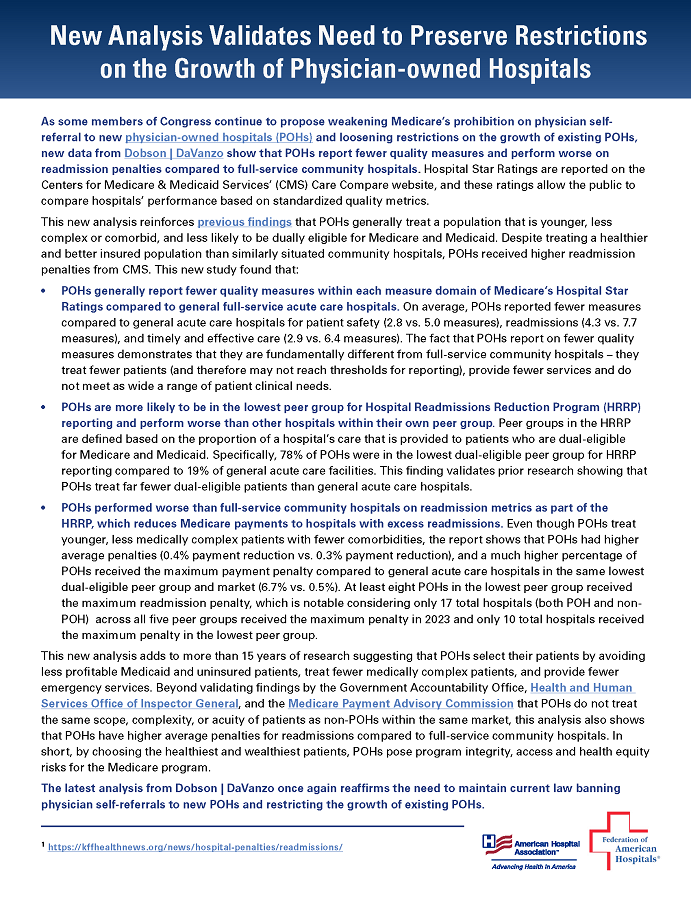

New Analysis Validates Need to Preserve Restrictions on the Growth of Physician-owned Hospitals
As some members of Congress continue to propose weakening Medicare’s prohibition on physician self-referral to new physician-owned hospitals (POHs) and loosening restrictions on the growth of existing POHs, new data from Dobson | DaVanzo show that POHs report fewer quality measures and perform worse on readmission penalties compared to full-service community hospitals. Hospital Star Ratings are reported on the Centers for Medicare & Medicaid Services’ (CMS) Care Compare website, and these ratings allow the public to compare hospitals’ performance based on standardized quality metrics.
This new analysis reinforces previous findings that POHs generally treat a population that is younger, less complex or comorbid, and less likely to be dually eligible for Medicare and Medicaid. Despite treating a healthier and better insured population than similarly situated community hospitals, POHs received higher readmission penalties from CMS. This new study found that:
- POHs generally report fewer quality measures within each measure domain of Medicare’s Hospital Star Ratings compared to general full-service acute care hospitals. On average, POHs reported fewer measures compared to general acute care hospitals for patient safety (2.8 vs. 5.0 measures), readmissions (4.3 vs. 7.7 measures), and timely and effective care (2.9 vs. 6.4 measures). The fact that POHs report on fewer quality measures demonstrates that they are fundamentally different from full-service community hospitals – they treat fewer patients (and therefore may not reach thresholds for reporting), provide fewer services and do not meet as wide a range of patient clinical needs.
- POHs are more likely to be in the lowest peer group for Hospital Readmissions Reduction Program (HRRP) reporting and perform worse than other hospitals within their own peer group. Peer groups in the HRRP are defined based on the proportion of a hospital’s care that is provided to patients who are dual-eligible for Medicare and Medicaid. Specifically, 78% of POHs were in the lowest dual-eligible peer group for HRRP reporting compared to 19% of general acute care facilities. This finding validates prior research showing that POHs treat far fewer dual-eligible patients than general acute care hospitals.
- POHs performed worse than full-service community hospitals on readmission metrics as part of the HRRP, which reduces Medicare payments to hospitals with excess readmissions. Even though POHs treat younger, less medically complex patients with fewer comorbidities, the report shows that POHs had higher average penalties (0.4% payment reduction vs. 0.3% payment reduction), and a much higher percentage of POHs received the maximum payment penalty compared to general acute care hospitals in the same lowest dual-eligible peer group and market (6.7% vs. 0.5%). At least eight POHs in the lowest peer group received the maximum readmission penalty, which is notable considering only 17 total hospitals (both POH and non-POH) across all five peer groups received the maximum penalty in 2023 and only 10 total hospitals received the maximum penalty in the lowest peer group.1
This new analysis adds to more than 15 years of research suggesting that POHs select their patients by avoiding less profitable Medicaid and uninsured patients, treat fewer medically complex patients, and provide fewer emergency services. Beyond validating findings by the Government Accountability Office, Health and Human Services Office of Inspector General, and the Medicare Payment Advisory Commission that POHs do not treat the same scope, complexity, or acuity of patients as non-POHs within the same market, this analysis also shows that POHs have higher average penalties for readmissions compared to full-service community hospitals. In short, by choosing the healthiest and wealthiest patients, POHs pose program integrity, access and health equity risks for the Medicare program.
The latest analysis from Dobson | DaVanzo once again reaffirms the need to maintain current law banning physician self-referrals to new POHs and restricting the growth of existing POHs.


